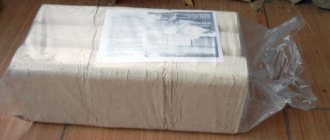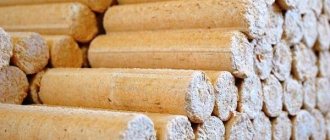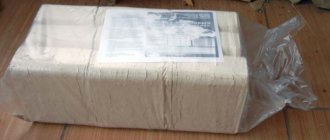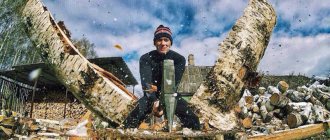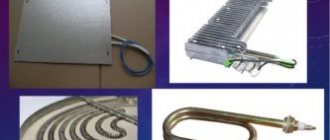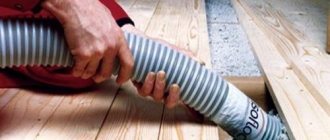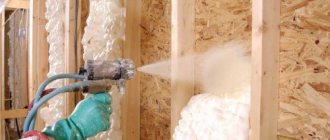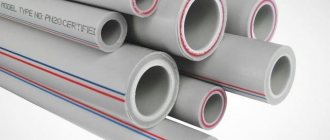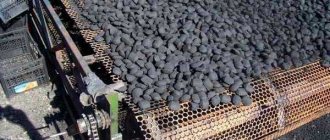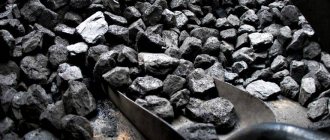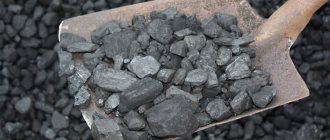Advantages of fuel briquettes and their comparison with firewood
Eurowood is a fuel that is used to reduce the cost of heating in European countries. The advantages include:
- increased calorific value;
- environmental friendliness;
- increased burning time;
- low release of resins;
- high density;
- low moisture concentration (10%, in firewood - from 20%).
The main criterion for comparison is price. Thus, 1 m of firewood costs 2 times less than the same volume of briquettes. But, there is a point - European firewood burns for 2 hours, and ordinary ones - about an hour, while the heat transfer from modern fuel is higher, since the fire is stable throughout the burning time. Coals and ash remain from the tree, but the briquettes burn completely. Therefore they are more profitable.
All your articles will be on this page.
Equipment and raw materials
You can create fuel briquettes with your own hands from various types of human waste. In principle, you can use any substance that can burn normally. What household waste can become valuable raw materials:
- First of all, wood, sawdust and shavings, wood dust, leaves and tree branches. The type of wood does not play a primary role, but it is better that the sawdust be birch, oak, alder or aspen.
- Straw left over from the harvest of wheat or corn.
- Cardboard and paper. It is much easier to make fuel briquettes from paper yourself than from wood, but the paper version will burn out faster.
- Residues and husks of seeds and nut shells can be good but rare raw materials.
The composition of briquettes can be different, and hence the different adhesive capabilities of the mixture. Depending on the raw materials used, clay is added to some briquettes to help bind the elements, usually in a ratio of 10 to 1.
Sawdust can be the best raw material
To create homemade fuel briquettes you will need special equipment. You can order an entire line for home production at once by contacting a specific company, or you can assemble the equipment in parts, because the technology for making fuel briquettes is essentially simple.
The whole technology is based on three stages of production:
- The first stage involves the initial preparation of raw materials. The existing waste should be crushed and crushed to the required consistency so that the composition of the mixture is homogeneous.
- The second stage involves bringing the mixture to a ready-made state by drying. The drying machine removes moisture from the raw material.
- The third stage involves the manufacture of products; here fuel briquettes are pressed on a special machine under high pressure and temperature.
Screw press for working with raw materials
Accordingly, for each stage you will need to select a machine suitable for your raw materials: a crusher, a dryer and a press.
Another difference with home production is that you can, in principle, eliminate the dryer from the line. You can dry raw materials and briquettes naturally under the sun. By the way, if the raw materials are ready-made sawdust or seed husks, then you may not need a crusher.
Particularly skilled craftsmen make the press themselves, based on their needs and capabilities. Nowadays, access to information is not limited, so drawings of any type of device can be found freely available on the Internet. By assembling your press according to the drawings, you can make a unique briquetted product that will burn perfectly in furnace fireboxes.
Friends who already deal with similar home-made or factory-made equipment can tell you how to make a press machine. You can choose a screw, hydraulic or shock-mechanical option.
Fuel briquette production machine
To install the equipment you will need a decent room. It will have to accommodate all the machines, raw materials and resulting products. It is advisable to provide comfortable conditions for drying so that the humidity of the briquettes is minimal, so take care of ventilation. To connect the machines you will need electricity, and since we produce fuel, we should not forget about fire safety measures.
Heating with eurowood
I would like to immediately note that ordinary firewood and modern briquettes are a priori different types of fuel, although their operating principle is identical. (Fuel briquettes are closer in nature to coal.) Ordinary firewood has been used for a very long time, but European firewood still has to prove its worth.
By the way, fuel briquettes received the original name “Eurofirewood” due to their similarity with classic firewood both in shape and technical characteristics.
Modern fuel briquettes are produced from food and natural waste. Wood (sawdust, shavings, wood dust, branches and even leaves), straw remaining after processing grain crops (wheat, rye, corn), husks and husks of seeds, nut shells, peat, and in rare cases even manure are actively used. When burning this kind of material, no harmful substances are released for humans and the environment. No other ingredients are added to fuel briquettes.
Fuel briquettes from various materials
Carefully prepared and crushed raw materials are subjected to temperature pressing, during which excess moisture is removed, the material is held together, and becomes dense and strong. Depending on the type of production, all fuel briquettes can be divided into three classes:
- The simplest one is Ruf fuel briquettes.
- More advanced - Nestro fuel briquettes.
- The most modern are Pini-Kay fuel briquettes.
These types of fuel briquettes differ in shape, final processing method (sometimes there is firing to give the final shape and protection from moisture), level of density, which largely depends on the shape of the briquette itself. The composition of Eurowood always remains the same, without adding third-party elements.
Why is Euro firewood so good? Let’s look at its main advantages:
- Created by pressing at high temperatures, Euro firewood has high density and low humidity. That is why the burning time of fuel briquettes is much longer than that of firewood. The level of heat transfer from briquettes is twice as high, which is explained by the same technical characteristics. Ordinary firewood, dried during the year, has a moisture content of about 20%, fresh wood 40-50%, and for fuel briquettes the same figure is 8-9%.
- Made using professional equipment, having the correct shape and good packaging, fuel briquettes are more compact, convenient and easy to store. At the same time, as we have already said, they burn longer and give off more heat than firewood, which means the fuel supply may be smaller. Heating a house with fuel briquettes in Europe is considered a normal practice, moderately economical. In Russia, wood is traditionally used.
Fuel briquettes of the correct shape
- Using fuel briquettes is extremely simple; the technology for burning them is no different from ordinary firewood. You could even say that they are safer to use since the level of fire and its operation can be controlled.
- When storing firewood in the house there is always a lot of garbage, but the briquettes are tightly packed in cellophane and loaded into the oven entirely.
- Eurowood burns with a stable fire, it does not spark or smoke, and the amount of smoke emitted can be called minimal. By loading briquettes into the oven in various ways, you can regulate the intensity of fuel combustion. A small amount of smoke allows you to save on cleaning the chimney from soot, and also allows the use of such fuel in black baths.
- After using fuel briquettes, very little ash remains, approximately 1% of the total volume of fuel. Unlike firewood, briquettes burn almost completely.
- With proper skill and suitable equipment, you can make fuel briquettes with your own hands. At first glance, the task seems impossible, but upon detailed analysis everything turns out to be very simple. In the future, such production will help significantly save the budget on fuel.
Simple cellophane packaging for fuel briquettes
Having considered the advantages of fuel briquettes, we move on to the disadvantages that also exist:
- Having a high density, European firewood takes a long time to burn in the firebox. When studying whether it is better to heat a stove, with wood or briquettes, you should definitely pay attention to this. You can't start a fire quickly with alternative fuels; you need the right materials. Even a good, dense, dry briquette takes a few minutes to warm up.
- When burning briquettes of some types, characteristic odors may be present. For example, the aroma of burning seed husks may not be to everyone's taste. The ash from Eurobriquettes smells absolutely disgusting, but despite this it is an excellent fertilizer.
- Fuel briquettes are afraid of dampness, even if they are burned on the outside. A product packed in cellophane is not afraid of moisture, but after being removed from a vacuum package, the briquette becomes vulnerable. Due to humidity, Euro firewood crumbles and becomes unsuitable for use.
- Mechanical impacts for Eurobriquettes are also unacceptable. Even when dry, you can break them, especially if they are of poor quality.
- Fuel briquettes are not capable of creating a unique atmosphere of warmth, comfort and coziness that is inherent in firewood. They do not crackle, the fire from them is too simple, smoldering, and the appearance leaves much to be desired, especially homemade options. From an aesthetic point of view, fuel briquettes are not suitable for use in a fireplace.
Burning briquettes in the furnace firebox
When choosing firewood or briquettes for heating your home, you should also analyze ordinary wood, at least for its merits.
Good to know: What can you use to heat a stove besides wood, consider peat and coal
Peat briquettes
Pressed peat fuel resembles large thick washers. Deposits of this raw material are found in swampy areas and are products of decomposition of plant and animal origin.
The extracted substance is dried under high temperature. The liquid mixture is poured into molds and placed in ovens. During processing, the peat is compacted. The resulting solid, round, black formations are obtained.
Peat products have high heat transfer rates and burn much longer than wood materials. Peat concentrate is a boiler fuel. With well-functioning boiler ventilation, briquettes loaded into the firebox will burn well one night for 8 hours. When peat is burned, ash remains, which can be used as fertilizer.
What characteristics do they have?
- calorific value ranges from 4200 to 4500 kcal/kg;
- the maximum ash level is 1%;
- humidity is in the range of 7–13%;
- The average density of briquettes is 750–800 kg/m3.
The numerical expression of the above characteristics of Ruf fuel briquettes will probably not tell an ordinary person anything.
To understand the effectiveness of using briquettes of this brand, let’s compare some properties of other types of fuel using the same indicators:
- Calorific value:
- brown coal – 3910 kcal/kg;
- wood – from 1500 to 3000 kcal/kg depending on humidity;
- hard coal – 4800 kcal/kg;
- Ruf briquettes – on average 4350 kcal/kg.
Ash content:
- brown coal – 40%;
- peat briquettes – 16%;
- hard coal – 20%;
- Ruf briquettes – 1%.
A comparison of two indicators is enough to understand one simple truth: Ruf briquettes are a very effective type of fuel for a heating boiler in a country home!
Why are briquettes better?
Their main advantage over firewood is their affordable price and high heat output. For example, the heat transfer of firewood at a humidity of 20% is about 3000 kcal/kg, and a briquette is 5000 kcal/kg. Compared to firewood, the moisture level of briquettes is 3-4 times lower, this is achieved due to the fact that they are almost completely dried. High density ensures excellent heat transfer; they also emit less soot and ash and do not pollute the chimney; they burn evenly, which is achieved due to a uniform and homogeneous structure.
Pressed products take up less space, are compact, and if you compare what is better for heating - firewood or fuel briquettes, then it is worth considering the disadvantages of each type of fuel.
Artificial firewood is sensitive to moisture, they are more expensive and very often the quality does not meet standards.
It is very difficult to visually distinguish between a good briquette and a low-quality briquette, since it is simply impossible to determine its composition externally. Soft wood waste and low-quality wood can be added to briquettes, which as a result significantly reduces heat transfer.
House heating
Fuel briquettes are probably ideal for heating a home. The ability to light the stove once and maintain the fire and heat for a long time without additional tossing allows us to talk about the good characteristics of Eurobriquettes. Let's look at how to heat a brick stove with fuel briquettes within the house.
Of course, pressed bricks will not burn immediately, so let’s figure out how to light fuel briquettes. This is quite simple to do; first of all, you should put tree bark, wood chips, and some dry newspapers in the oven, and then place alternative firewood on top. During kindling, while the wood chips are actively igniting, we adjust the airflow. As soon as the fire starts on the first briquettes, you can add the rest.
Another option is to heat the stove with fuel briquettes after the first batch of wood has burned and decent coals have appeared. In such a firebox, the fire can quickly be caught on Eurobriquettes.
Preparing to light the stove
Depending on your needs, we choose the tactics for filling the stove with fuel:
- If you stack the fuel briquettes loosely, at a short distance from each other, the fire in the stove will be quite intense and will generate a lot of heat, which will allow you to quickly heat the house.
- If you stack alternative firewood tightly to each other and cover the vent, the firewood will smolder for a longer time, which is perfect for heating a house at night. At the same time, the consumption of fuel briquettes per day will be several times less than firewood.
In order to roughly understand how many eurobriquettes will be required to heat a house, you should conduct several experiments, each time finding out this parameter in practice. There are too many nuances in this matter.
It is worth noting that fuel briquettes have a specific purpose - to create heat, while firewood can be considered for the purpose of creating a comfortable and cozy environment. For example, is it possible to light a fireplace with fuel briquettes - well, of course, yes, but they will not create the same atmosphere as firewood with its pleasant crackling and uneven fire. By the way, the smell from burning wood is stronger and more pleasant.
In conclusion, I would like to say a little about the storage of Eurobriquettes and compare it with the preparation and storage of firewood. Fuel briquettes are sold in separate packages wrapped in cellophane. In this state, they are not afraid of moisture, which means they can be placed in a utility room, attic, basement or shed. Eurobriquettes look like bricks or tubes, all of the same shape, which is very convenient for storage. In addition, they take up much less space, since for the winter they will be needed several times less than firewood.
If we remember what difficulties await us when collecting firewood, there is food for thought when choosing the appropriate fuel. Eurobriquettes do not need to be sawed, split, stored and dried throughout the year; they are already ready for use.
Heating with regular wood
Firewood has been used for heating for a very long time; it is a high-quality fuel for the home and bathhouse, barbecue and barbecue. The environmental friendliness of firewood will always be 100%, and this fuel has plenty of other advantages. Let us note the main advantages of firewood, without delving deeply into this topic:
- First of all, I would like to say that the process of harvesting, drying and storing firewood is understandable to everyone. From an early age we know how to look for firewood, collect and light it.
- Lighting wood is not difficult, even when it is damp. Some tree varieties can burn in high humidity, giving off heat.
- The cost of firewood is low, even if you do not go through the entire harvesting cycle, but buy ready-made logs or logs. (However, until the prices of different types of fuel are compared, it will not be possible to say which is more profitable.)
- Firewood is not afraid of mechanical damage and can be stored in a woodpile in completely different ways.
- From an aesthetic point of view, the wood burns perfectly. They create a beautiful fire and soulful crackle, and when some varieties burn, a characteristic pleasant aroma appears. For open fireplaces, where the appearance of what is happening is important, this fuel is considered optimal.
- The substances released during the combustion of wood have a beneficial effect on humans, they calm the nervous system and heal the respiratory system.
Strategic forest reserve for winter
We will also highlight the disadvantages of natural fuel:
- To obtain high heat transfer, the firewood should be well dried under natural conditions, which requires an extremely long time, for example, 1 or 2 years. The best firewood is wood that has lain in a dry shed for a couple of years.
- During long-term storage, wood loses some of its qualities, especially fragrant varieties of trees.
- Firewood takes up a lot of space; for its normal storage in the required quantity, it is necessary to build an appropriate structure.
- When using firewood, a lot of debris always appears (chips, bark, wood dust, sawdust).
Good to know: Fuel briquettes for fireplaces and stoves, general information about modern fuel
Having become acquainted with the main capabilities of the two types of fuel, let's make a comparison.
The main advantages of briquettes
The use of the elements in question for heating has undeniable advantages, which we will consider:
| Independence | You don't need a gas pipeline, and if you have a home heating system with natural circulation, then you don't need electricity either. The main thing is that there is fuel available. This factor is especially important in areas that are subject to interruptions in electricity and gas supply and in suburban areas |
| Low price | The cost of briquettes is very affordable, and if you compare their efficiency with the cheapest option - wood, the difference is small, because a comparable volume produces almost twice as much heat |
| Convenience | In boilers with adjustable air supply, the burning time of one bookmark can be 7-10 hours, which allows for comfortable sleep and stable heat throughout the day when no one is home |
| Environmental friendliness | The amount of emissions into the atmosphere is small, while a relatively small volume of ash is formed, which allows cleaning the firebox several times less often |
After combustion, wood compacts leave virtually no ash
What is better - firewood or fuel briquettes?
Now briquette fuel, or pellets, is quickly gaining popularity among owners of cottages, dachas, and country houses. And this is not surprising, because, unlike ordinary firewood, briquettes do not require splitting, and during the combustion process they do not produce acrid smoke, ash and dirt. In addition, the efficiency of briquette fuel is five times greater than that of traditional fuels.
Briquette fuel burns twice as long as regular logs. This is preferable for stoves with a long burning period. And in stoves or fireplaces with a fast combustion cycle, it is better to use wood, given their high heat output.
Production of fuel briquettes from paper and cardboard
As mentioned above, you can make your own fuel briquettes not only from wood waste, but also from other types of raw materials, in particular paper and cardboard. Fuel briquettes made from these materials can be an excellent alternative to firewood and can be successfully used for heating homes. The advantages of paper fuel briquettes, in addition to the low cost of such fuel, also include:
- a fairly long burning time, which is about two hours;
- high heat transfer, the value of which even exceeds that of briquettes made from coal chips;
- low ash content, the value of which is about 5% of the total mass of fuel used.
Almost anyone can make such a biofuel “pill.”
In this regard, many home craftsmen are thinking about how to make paper briquettes with their own hands. To create fuel briquettes from such accessible raw materials, you can use the simplest pressing equipment, which is easy to make yourself. The power element of such a press, which will create the pressure required for pressing the soaked raw material mass, can be a screw, lever or hydraulic mechanism.
A sewer pipe and thick plywood are suitable for making the mold.
The bottom plate must fit tightly into the pipe
A small amount of a mixture consisting of paper, sawdust and adhesive can be kneaded in a basin using a drill mixer
Any hand press is used to compress the mixture.
Thus, realizing the desire to form fuel briquettes from sawdust with your own hands (or a similar type of fuel from any other suitable raw material) is quite easy. The main thing to be guided by when deciding to organize such a home production is the ability to provide it with the required amount of cheap raw materials. Only if such an opportunity exists is it advisable to make Euro-firewood at home.
Coal
Among various types of solid fuel, coal has the greatest heat transfer, which makes it one of the most efficient energy carriers in heating boilers. The amount of heat released during the combustion of coal is twice as high as that for wood and is about 7.5 kWh/kg.
Thus, to maintain a certain temperature of the coolant in the circuit, coal will require significantly less than other types of solid fuel.
The most efficient in terms of heat production is anthracite. It contains a minimum of moisture and impurities. However, it is very expensive and burns quickly, giving a very high temperature, which is simply not needed in heating boilers.
The advantages of coal are due to its physical and chemical properties:
- High calorific value. The main plus. With proper boiler design, a bucket of coal may well last for a day. The volume of fuel reserves purchased for the heating season is smaller, this is especially beneficial for small or densely built-up areas.
- Coal is not afraid of moisture. Although coal pits and sheds are built for storing coal, the inside of them does not need to be as dry as possible. When wet, coal retains its properties when it dries, since moisture does not penetrate inside.
- When burned, coal produces a very high temperature, which wood and its derivatives cannot produce. This allows the coolant in the circuit to be heated more efficiently with less fuel.
Unfortunately, coal is quite expensive. Even taking into account the fact that it produces more heat, there may not be any economic benefit from its use. Another thing is the location near famous coal basins. In these regions, coal is always cheaper and much easier to buy. In places of deposits, coal almost completely replaces firewood from use.
Fire safety! When dumping coal into large piles, there is a danger of spontaneous combustion. The fact is that a mineral extracted from the bowels of the earth oxidizes in the air, which leads to self-heating. When the critical point is reached, the coal ignites inside the heap - slow burning occurs.
To prevent self-ignition, coal is stored on a non-combustible substrate and poured in layers
You should also be careful when firing a boiler with coking coal, which is sometimes purchased by owners of plots located near enrichment plants. If used incorrectly, coke can produce such a high temperature that a steel and even cast iron furnace burns through, rendering the boiler inoperable.
Is it better to heat a stove with coal or wood?
In the Moscow region, many different types of solid fuel are sold that are used in stoves. Starting from the popular: firewood, pellets, briquettes and coal and ending with the rare: dung and peat briquettes. At the moment, according to independent research, the most popular types of fuel are coal and firewood. Moreover, both wood and coal have their own advantages and disadvantages, which should be taken into account when choosing and purchasing fuel.
Coal is a mineral, a type of fuel formed from parts of ancient plants underground without access to oxygen. The international name for carbon comes from lat. carbō ("coal"). Coal was the first fossil fuel used by humans. It enabled the industrial revolution, which in turn contributed to the development of the coal industry, providing it with more modern technology.
On average, burning one kilogram of coal leads to the release of 2.93 kg of CO2 and produces 23-27 MJ (6.4-7.5 kWh) of energy or, with an efficiency of 30%, 2.0 kWh of electricity . Coal can be of different grades - brown, black and the best - anthracite. The latter releases more heat during combustion and less is required to achieve the required temperature.
Firewood - pieces of wood - timber - intended for burning in a stove, fireplace, firebox or fire to produce heat and light. In accordance with the requirements of GOST 3243-88, the quality of firewood in Russia is standardized by wood species, nominal length and accounting gradation, by the area of core rot (as a percentage of the end area), by the amount of firewood in a batch with rot from 30 to 65% of the end area, and by the height of the remaining branches.
So, let’s return to the question that concerns us: what is better, wood or coal for heating?
Coal is well suited for combustion in heating system boilers installed in separate rooms, outbuildings or a separate boiler room. It is not recommended to use it in stoves installed in residential premises. Since coal burns for a long time and practically does not burn completely in the furnace firebox, and therefore you cannot close the chimney, you always have to leave it a little open so as not to get burned by carbon monoxide. At the same time, dry wood burns quickly and provides enough heat to warm up the stove. The firewood burns to the end, and you can safely close the valve on the pipe and thereby slow down the cooling of the stove and the loss of heat through the chimney.
It is very difficult to light coal without logs or special ignitions. Therefore, even those who heat their stoves with coal still buy wood to ignite coal. The best firewood in terms of heat transfer is oak firewood, but they are expensive, so birch firewood is optimal in terms of price/heat transfer ratio.
People who burn coal know very well that coal dust is harmful to the human body. And when throwing the next batch of coal into the firebox, it is rarely possible to “not raise dust” and not stain everything around with coal dust. Firewood is mostly free of dirt and foreign impurities.
Wood heating is the most environmentally friendly compared to coal. Since the combustion of wood releases a minimal amount of carbon dioxide, it cannot cause much harm to the biosphere, compared to coal.
Therefore, when you choose between coal and firewood, we strongly advise you to choose firewood. This is both safer for health and more profitable from the point of view of maintaining cleanliness in the house.
Financial plan
Drawing up a financial plan will help determine the amount of necessary investments, further monthly expenses and income, as well as the payback period of the enterprise. In each individual case, these amounts can vary significantly, but it should be borne in mind that the initial investment will always be quite high.
Starting investments
The main costs at the start will be associated with the purchase of equipment. To create a production line you will need:
| Name | Average cost, rubles |
| Crushing apparatus | 100000 |
| Aerodynamic dryer | 800000 |
| Press shock-mechanical screw | 1500000 500000 |
| Feed auger | 80000 |
| Cyclone filter | 35000 |
| Heat generator | 150000 |
| Remote controller | 15000 |
| Band conveyer | 200000 |
| Packing machine | 400000 |
The total cost of equipment with a screw press will be 2,280,000 rubles, and with a mechanical impact press - 3,200,000 rubles. It should be taken into account that the first has a productivity of about 250–300 kg/hour, and the second – 1000–2000 kg/hour, depending on the model.
If we take equipment costs to a minimum (with the purchase of a screw press), then taking into account other costs, the initial investment will be approximately as follows:
| Article | Amount, rub. |
| State registration: payment of duty paperwork | 5000 4000 1000 |
| Arrangement of the premises: Repair Furniture for office and service premises Warehouse equipment | 300000 100000 100000 100000 |
| Purchase of equipment | 22800000 |
| Purchase of raw materials | 10000 |
| Advertising campaign | 45000 |
| Unexpected expenses | 50000 |
In total, starting a business will require 2,420,000 rubles.
Monthly expenses
In the course of business, costs are significantly reduced. First of all, you will need to pay employee salaries, which will be:
| Job title | Salary | Number of staff units | Total monthly payroll |
| Director | 35000 | 1 | 35000 |
| Accountant | 30000 | 0,5 | 15000 |
| Operator | 25000 | 4 | 100000 |
| Equipment adjuster | 25000 | 1 | 25000 |
| Helper worker | 20000 | 4 | 80000 |
| Driver | 20000 | 1 | 20000 |
| Office cleaner | 20000 | 0,5 | 10000 |
The entire monthly wage fund will be 285,000 rubles.
The next major cost will be related to electricity bills. Given the high power of the equipment, on average you will have to pay about 50,000 rubles per month for utilities. In addition, it is necessary to take into account the cost of raw materials and other expenses, which in general will cost the following amounts:
| Articles | Cost, rubles |
| Rent | 70000 |
| Payroll | 285000 |
| Payment of utility services | 50000 |
| Administrative expenses | 10000 |
| Tax payments | 80000 |
| Purchase of raw materials | 10000 |
| Unexpected expenses | 20000 |
The total amount of all monthly expenses will be 525,000 rubles, of which more than half will go to wages. Therefore, as production expands, it is recommended to take care of its maximum automation.
Income
The income of an enterprise producing fuel briquettes using the auger method is calculated according to the following scheme:
- number of working hours for 2 shifts – 16;
- number of working days per month – 30;
- equipment productivity – 300 kg/hour.
It turns out that the workshop will produce about 150 tons of products per month. The average market price of 1 ton of fuel briquettes is 6,000 rubles. Consequently, the monthly revenue will be 900,000, and the net profit will be 375,000 rubles.
As a result, the initial investment will pay off in 6–7 months of full-time work. But since it will be possible to reach the indicated volumes at least 3 months from the start of production activities, we should expect that the payback period will be about 1 year.
The business of producing fuel briquettes is a profitable and very promising direction. The main thing is to find the necessary financial resources to launch it, to properly organize work and sales of finished products. The activity itself is simple and highly profitable, so it can be an excellent startup for the future development of your business.
Business planning
It is advisable to start opening a mini-factory for the production of fuel briquettes by drawing up a business plan. It is better to order a full feasibility study of the project from specialists. You can also make an approximate calculation of economic indicators yourself by collecting certain data for your region: prices for equipment and its technical characteristics, the cost of raw materials, the cost of utilities, etc.
The main goal of developing a business plan for the production of fuel briquettes is to draw up a program of economic activity of the enterprise, within the framework of which it is optimal to distribute available resources to achieve the set goals. During its development, it is necessary to find out the degree of reality of achieving the intended results. It must reflect the reasonableness of the costs and profitability of the project. It is useful to learn how to write a proper business plan. Approximate data for calculating the profit and payback period of the project are given in the following table:
| Costs for production of 1 ton of briquettes | ||
| 1. | Raw materials (2 tons) | 400 rub. |
| 2. | Electricity (100 kW/hour) | 550 rub. |
| 3. | Thermal energy (1 MW/hour) + price of dry wood waste | 100 rub. |
| 4. | Salary (2 employees per shift at a rate of 20,000 rubles/month with taxes) | 360 rub. |
| Total: | 1410 rub. | |
| Income | ||
| 1. | Productivity per month for single-shift work (0.5 t/hour × 8 hours × 21 days) | 84 tons |
| 2. | Capacity per year (84 tons × 12 months) | 1008 tons |
| 3. | Minimum selling price | 5000 rub./t |
| 4. | Revenue per month | 420,000 rub. |
| 5. | Revenue per year | RUB 5,040,000 |
| 6. | Profit per month | RUB 301,560 |
| 7. | Profit per year | RUB 3,618,720 |
This table shows only direct costs; packaging, delivery, taxes and other mandatory payments are not taken into account. In addition, productivity largely depends on the quality of equipment and the level of qualifications of personnel. But, as practice shows, such productions pay for themselves in an average of two years of operation.
Briquette composition
The materials for making Euro-firewood are usually various wood species, straw, cereal or seed husks, peat and coal. Let's look at them in more detail.
- Tree. The base function in such products is performed by compressed sawdust, shavings, bark and other non-format materials. First they are heated, and then they take shape using a press. And when heated, wood pulp releases a special substance - lignin, which, due to its qualitative characteristics, resembles glue. Thanks to lignin, briquettes retain their shape throughout the entire period of production and operation. An alternative to firewood in the form of fuel briquettes has a high calorific value - approximately 4300-5000 kcal/kg.
- Straw. Euro firewood from straw is made in a similar way. Their calorific value is slightly lower than that of previous briquettes - 4740 kcal/kg.
- Seed husk. Fuel from seed processing residues has the highest calorific value - 5151 kcal/kg. This is due to the presence of oil components in their composition. But you should be careful when using this fuel constantly. Although it burns well, it pollutes the chimney very much, which can soon lead to its clogging and malfunction of the entire structure.
- Cereal husk. This type of fuel is produced from rice husks. It has a relatively low heat transfer: approximately 3458 kcal/kg.
- Peat. The peat mass is pre-dried and only then pressed. During this, the material is compacted, which makes it possible to produce small products that are convenient to use and transport. Fuel briquettes for peat stoves emit 5000 kcal/kg during combustion. This is significantly more than the figure for conventional firewood - 3910. Therefore, they are much more economical. The best briquettes for a long-burning stove are made from this material. Ash from environmentally friendly fuels is often used as fertilizer in household plots and gardening.
- Coal. This fuel is made from coal dust. To do this, waste from the coal industry is crushed, sifted, and then also pressed. Coal briquettes for heating stoves do not produce much smoke. The same cannot be said about hard coal fuel.
Basic properties and classification of material
Briquettes are made from various waste from woodworking and agricultural enterprises:
- from sawdust, bark, branches;
- made of straw;
- from plant waste;
- from grain husks;
- from reeds;
- from peat;
- from waste from flax processing;
- from screenings of hard coal;
- from grapevine.
Due to its versatility, this type of fuel can be used in various fields: in boiler rooms; for heating residential buildings, baths, saunas, greenhouses and many other objects.
Externally, briquettes are similar to ordinary firewood; their diameter is 10 cm and length is about 25 cm. The strength of this material is given by the substance lignin, which, under the influence of pressure and temperature, begins to melt and bind its particles.
Advantages of fuel briquettes:
- Emission of a small amount of soot and smoke, the ash content of Eurowood does not exceed 1.5%. If peat briquettes are processed, the ash can subsequently be used as phosphate or lime fertilizer.
- The burning time of wood briquettes is three times longer than that of conventional firewood, so they do not need to be loaded into the stove frequently.
- Affordable price.
- Compact and easy to transport.
- During combustion, environmentally friendly fuel does not emit harmful substances.
Depending on the briquette manufacturing technology, they can have different shapes:
- NESTRO is Euro firewood, which is made in the form of a cylinder. An impact press is used for their production.
- Pini&Kay are multifaceted products with holes. For their manufacture, a special press is used with a working surface pressure of 1100 bar. After pressing, they undergo a heat treatment procedure, as a result of which they acquire a dark brown tint.
- Briquettes ruf (ruf) after processing take the shape of a rectangle. They are produced using a hydraulic press with a pressure of 400 bar.
Fuel briquettes
Fuel briquettes (also called “eurowood”) are a special type of fuel based on plant materials. In particular, waste from the wood processing industry - wood chips and sawdust - as well as other herbal raw materials are used for their production. Fuel briquettes may also include rice and buckwheat husks, seeds, straw, peat and hay.
In this case, fuel briquettes are produced exclusively by pressing. Plant raw materials do not stick together in them, so “Eurowood” does not contain harmful substances. They can be used in fireplaces, stoves and other heat sources used to heat residential premises.
Important! It is worth noting that fuel briquettes, like basically any other substance, emit carbon dioxide when burned. So stoves, stoves, fireplaces and other heating devices where they are planned to be burned must be connected to a cleaned and working hood (chimney).
In general, fuel briquettes are characterized as follows:
- A source of small, slow and smoldering fire. However, the heat from them is sufficient to be used as fuel for heating or cooking systems;
- Extremely sensitive to getting wet. It is not recommended to store fuel briquettes in the open air or in suspended structures, since their close to porous structure easily absorbs moisture from the surrounding air;
- They have the correct geometric shape and the same size. This makes them easier to fold and store;
- The quality of combustion varies depending on the composition of the briquette and the manufacturer. But it is approximately the same for all varieties. In general, fuel briquettes do not burn, but simply smolder hotly.
The most important advantage of fuel briquettes compared to other types of fuel is their long burning time. Of course, it varies depending on the specific “variety,” but on average it takes 2-4 hours. High returns are maintained throughout the entire smoldering time.
So, let's summarize.
Advantages
- They have an increased heat capacity, thanks to which they can smolder hotly, heating the room, for 2-4 hours;
- It is convenient to store because they have the correct geometric shape and the same dimensions of each fuel briquette.
Flaws
- They require storage in a dry, closed place, since they easily absorb moisture even from the surrounding air;
- They have low mechanical strength and are easily broken and destroyed upon impact;
- When burning, they emit a specific, unpleasant burning odor;
- They leave behind a lot of ash.
The advantages also include the small amount of smoke released during combustion. Thanks to this, fuel briquettes do not smoke the room even if the ventilation is not functioning properly. However, the amount of carbon dioxide (carbon dioxide) released remains the same, so they can only be used in stoves with a properly functioning chimney.
Briquettes or firewood?
Although Euro firewood is usually made from wood waste, it has completely different characteristics. Euro firewood is aesthetically pleasing and easy to store and use. They burn slowly and provide more heat. But the amount of heat from briquettes is much less than from firewood.
Therefore, it will take a little longer to heat a house in severe frosts than with wood heating. And this causes some inconvenience. The ash content of alternative fuels is low.
But their ashes have a pungent odor, which may not please others. Briquettes do not create aesthetic pleasure, because they burn without noise or crackling. Using firewood is much more pleasant: you can create a cozy atmosphere.
Is it better to heat the stove with wood or briquettes? There is no clear answer to this question. The optimal heating scheme for a house: burning both types of fuel (classical and alternative) simultaneously.
It is better to achieve the optimal temperature using ordinary firewood, and then only maintain it with briquettes. The use of briquettes alone should be used for long-burning stoves. This way you will save yourself from the need to constantly add a new batch of firewood.
What fuel should I use in my stove?
An important factor for maintaining a constant temperature is the correct choice of long-burning stoves, which are refueled periodically and the fuel in them burns much longer. Owners of country houses or summer cottages can use artificial firewood to heat their premises, but it is convenient to use briquettes to light a fireplace. To do this, it is better to place them on paper and birch bark, which will speed up the ignition process. In the same way, you can use firewood, which does not always light well. To prevent soot from remaining as sediment in the chimney, it is recommended to throw a pinch of table salt into the fire with each addition.
What are fuel briquettes?
If you buy a solid fuel boiler, you will probably see a point in the instructions that specifies that the firewood for it must be completely dry. It is difficult to buy them: the material that is brought from the seller must be dried for a couple of years. To avoid unnecessary hassle, buy fuel briquettes created by pressing sawdust.
They contain birch dust, and after loading fuel into the boiler, it burns for at least 6 hours. There is no moisture in the briquettes, so the heat generation will be more abundant than when using traditional fuel. And most importantly, after combustion they leave a minimum of ash: this means that you do not have to clean the boiler often (or remove ash from an old stove).
How to properly heat a stove with briquettes
When igniting the stove and firing it, you should adhere to the following recommendations. First, the stove must be cleaned of the remnants of the previous combustion. Then a small amount of paper or dry wood chips is placed on the grate. Briquettes are laid loosely on top of the paper if quick combustion is needed. If prolonged burning is required, fuel briquettes should be placed closer to each other. After this, you need to set fire to the paper or wood chips. The most convenient way to do this is with a gas burner. Then you should wait until at least one briquette begins to smolder. And only after this you need to close the stove vent. It is important here to prevent rapid combustion; the briquettes should smolder. Thus, their potential will be revealed gradually and evenly.
A little advice - to reduce soot settling in the chimney, you need to throw a pinch of salt on the pellets or firewood before lighting.
Summarizing the above, we can say that fuel briquettes are an excellent environmentally friendly replacement for firewood and coal. To choose quality products, when purchasing, you should read the test report, which will indicate the main characteristics of the briquette fuel.
Types of LED lamps
There are special designs of LED lamps, the appearance of which resembles a fluorescent lamp and other lighting devices of this type.
They are a tube with a power supply and can be manufactured in the following options, depending on the material:
- Tube with a diameter of 26 mm made of solid transparent or matte polycarbonate. Due to their strong glow, such LEDs are placed in closed lampshades. Matte coatings partially absorb the light flux, and this factor should be taken into account when calculating power.
- Double-sided design. On the outside there is a part of the body made of a chemical alloy, and on the rear there is a round aluminum profile. Matte or transparent material is used as a diffuser.
Some types of lighting fixtures are equipped with a rotating mechanism that allows you to adjust and direct the light flux in the desired direction at a given angle. All tubes have standard lengths of 600, 900, 1200 and 1500 mm.
In residential premises, instead of a fluorescent lighting system, it is recommended to install lamps with a length of 600 and 1200 mm, which have sufficient power and optimal luminous flux. The power of the lamps varies between 9-25 W, including 18 W, and the light emitted can be cold or warm.
The LEDs and power supply are located inside the tube on a special getinax strip. Such lamps do not require an external source, and are connected directly to the electrical network. Power is supplied to pins located in the base and connected by copper wire. The T8 design practically does not need to be modified and the problem of how to remake it needs to be solved. After removing unnecessary parts, the device can be immediately connected and put into operation.
